Style
‘Fashion Is a Great Unifier’: How the Couture of Yves Saint Laurent Is Bringing Six Paris Museums Together in an Unprecedented Joint Show
The Louvre and the Pompidou are among the participating museums.

The Louvre and the Pompidou are among the participating museums.

Christine Ajudua

On January 29, 1962, a 26-year-old Yves Saint Laurent staged the first show for his eponymous haute couture house with his business partner and then-lover, Pierre Bergé. Over the next four decades, the Frenchman came to be known not just as a designer, but as one who interwove fashion and the fine arts—a career that aptly culminated in 2002 with his final runway show at the Centre Pompidou in Paris.
In 1983, Saint Laurent became the first living fashion designer to have a retrospective of his works in an art institution, curated by none other than Diana Vreeland, at New York’s Metropolitan Museum of Art. Now, the late couturier has become the subject of another first: “Yves Saint Laurent aux Musées,” an exhibition spanning six of Paris’s most iconic museums (open now until May 15, 2022), all of which Saint Laurent frequented.
The Centre Pompidou, the Musée d’Art Moderne de Paris, the Musée du Louvre, the Musée d’Orsay, the Musée National Picasso-Paris, and the Musée Yves Saint Laurent Paris are simultaneously displaying a selection of Saint Laurent’s most iconic designs—including dresses that translate paintings by the likes of Pierre Bonnard and Piet Mondrian, “like masses of colors in motion,” as he described them—within their permanent collections.
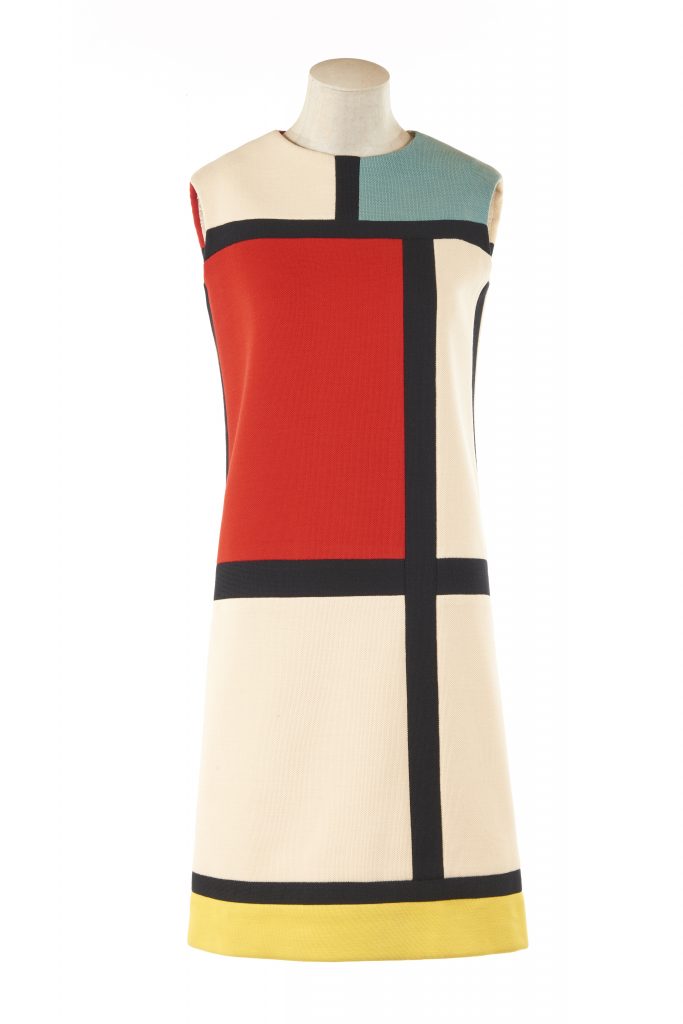
Hommage à Piet Mondrian, a dress from Saint Laurent’s fall-winter 1965 collection. © Yves Saint Laurent @ Nicolas Mathéus
Never before have the French capital’s fine art institutions come together in this way—with minimalist scenography from designer Jasmin Oezcebi as a unifying thread—not even for the finest and most famous of French artists. (Henri Matisse? Claude Monet? Pablo Picasso? Non, non, et non.)
“Yves Saint Laurent—the man, the creator—occupies a very particular place within French culture, a very magical place for many French of a certain generation,” said Madison Cox. The American garden designer is president of the Fondation Pierre Bergé–Yves Saint Laurent and one of the exhibition’s curators. Bergé’s widower, he was also involved with Saint Laurent. “By the time I knew him, in the late ’70s, he was like a pop star.”
But really, “He was an artiste manqué—an unfulfilled artist.”
As the designer once said, “The eternal face of fashion pursues its endless changes. In this way it joins Egyptian bas-reliefs, Greco-Roman statuary, the frescoes of Pompeii, the portrait of Agnès Sorel by Fouquet, Botticelli’s sunrises, Rembrandt’s gold, Franz Hals’s sooty regents, Velasquez’s silvery vessels, Watteau’s pearly rocks, the mists of Goya’s Majas, the barbaric sumptuousness of Delacroix, Ingres’s academic trap, Rossetti’s sensual romanticism, Renoir’s downy quilts.”
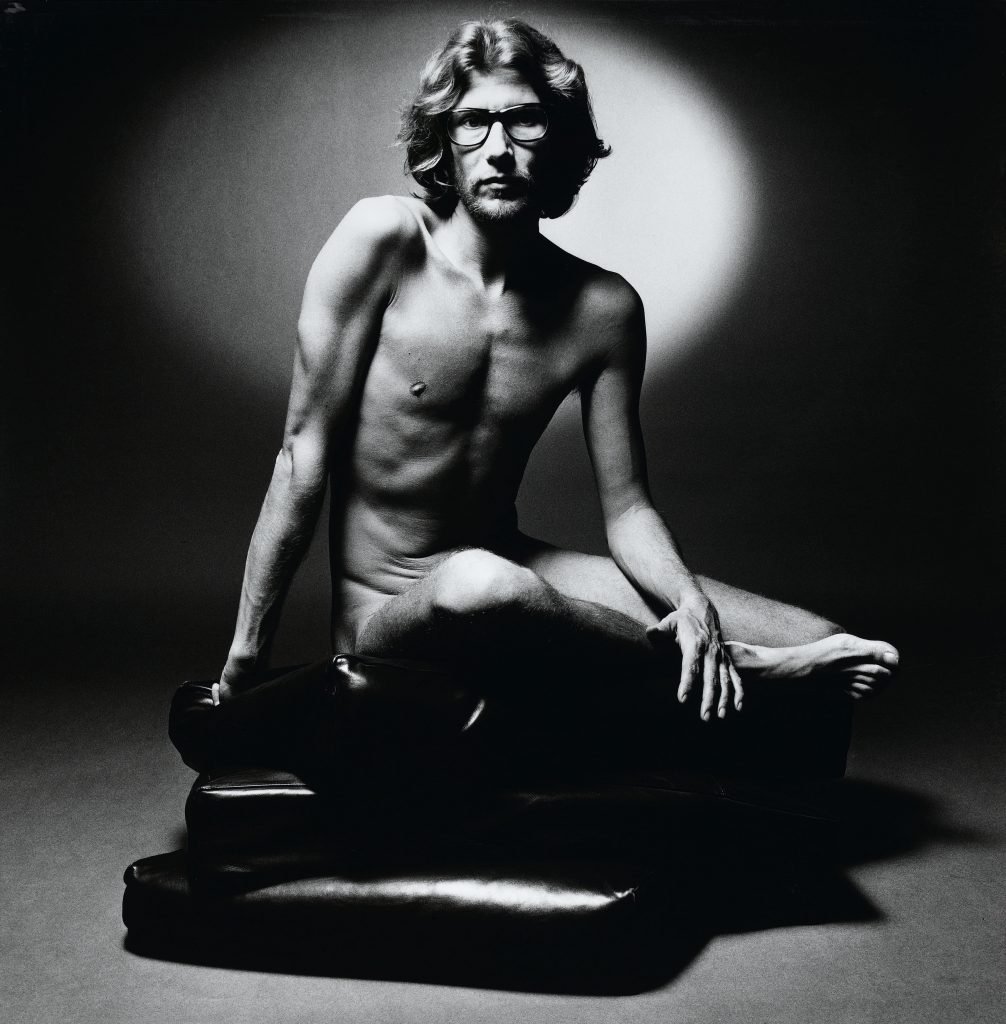
Jeanloup Sieff, Portrait de Yves Saint Laurent, 1971. © Estate of Jeanloup Sieff. © Centre Pompidou, MNAM-CCI, Dist. RMN- Grand Palais / image Centre Pompidou, MNAM-CCI.
To celebrate the fashion house’s 60th anniversary, Cox said, “The general idea was, How can we do something that we haven’t done before? Yves Saint Laurent has always been at the forefront as an innovator in his industry. The large retrospective exhibition, it had been done already—and it had been done fantastically, magnificently, in Paris. We had to find another method in which to exhibit his work—to honor his legacy, make it even more innovative and more inclusive of different generations.”
“Saint Laurent’s inspirations are so vast, and there’s a multitude of different examples. And so we said, ‘Well, what about if it was in different locations?’”
Staging an exhibition of this scale is a remarkable feat—perhaps particularly in France, where cutting through red tape is itself an art form, and especially now, while Paris is still reeling from a recent game of musical chairs that installed new presidents at four of the six participating museums. Though this has benefits, too. “They’re young, they’re dynamic, and they’re looking at other ways of how you bring in people, and how you excite them,” Cox said.
“It was a crazy idea,” he said of the exhibition—and initially, it was even crazier. “We were hoping to have many more [museums].” In fact, when Cox and his co-curators, Mouna Mekouar and Stephan Janson, began planning the exhibition two years ago, they were looking to stage a parallel production at multiple institutions in New York.
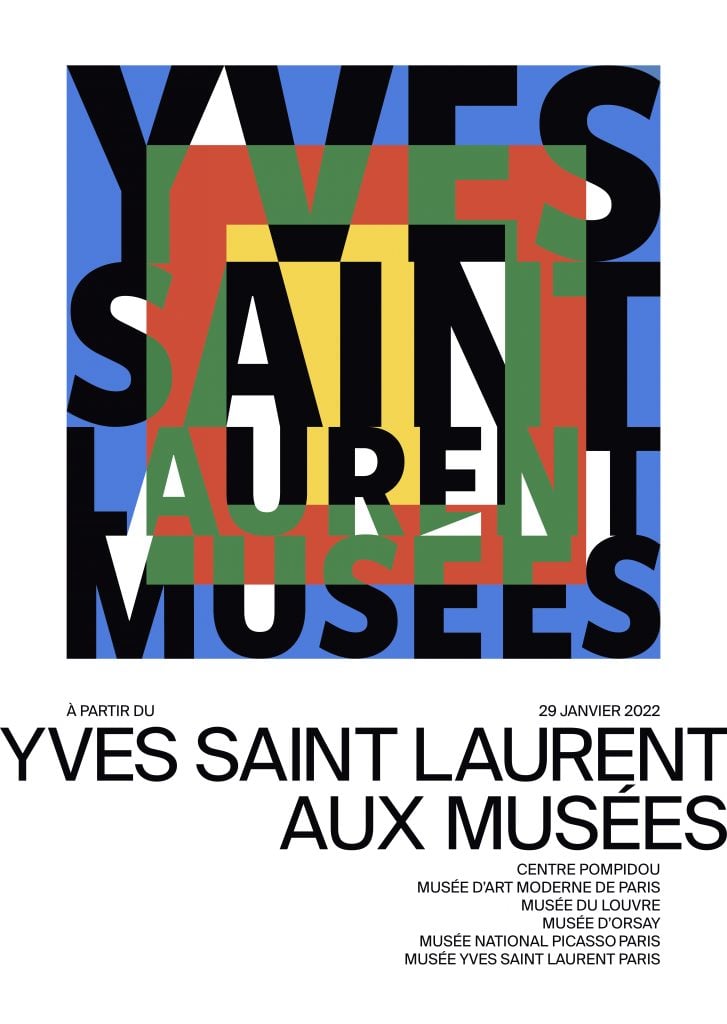
Courtesy of the Fondation Pierre Bergé–Yves Saint Laurent.
Then came March 2020. “You probably remember, the world basically came to a crashing end,” he said. The foundation nixed the transatlantic idea and decided to focus on Paris, where Saint Laurent and Bergé were patrons of many museums. “Given the context of a moment—cultural institutions were decimated—I think they were all realizing, Well, we’ve got to look at alternatives. These museums had never really thought of, How can we pool our resources? How can we unite?”
“You know, fashion is a great unifier—old and young, well-versed or not, people are fascinated by looking at it.” The exhibition became, he said, “like a beacon of hope.”
“Fashion was not part of our collection domains,” said Marie Sarré, associate curator at the Centre Pompidou. “However, [our] participation in the project was an obvious choice. Saint Laurent transposed artistic modernity to fashion design. Some of [his] pieces seem to have been made yesterday—they traverse time.”
But more than the designs on display, the exhibition spotlights Saint Laurent’s constant dialogue with the artists and institutions of Paris. As Sarré added, “This is a unique opportunity to remind us how rich and varied the collections of Parisian museums are. Visitors who usually visit the Louvre will now make their way to the Centre Pompidou. Likewise, our visitors may visit the Musée d’Orsay.”
Below, see images from the six institutions staging “Yves Saint Laurent aux Musées.”
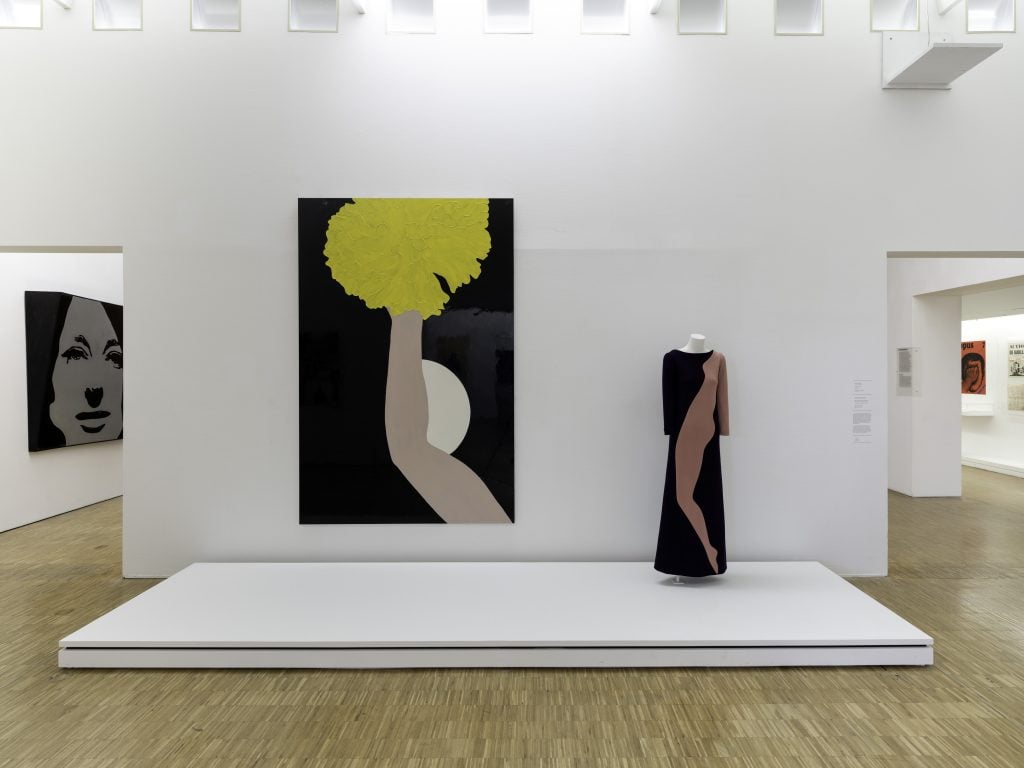
Gary Hume, The Moon, 2009, paired with Saint Laurent’s fall-winter 1966 dress, Hommage à Tom Wesselmann. © Centre Pompidou @ Hélène Mauri.
“It was no coincidence that Saint Laurent chose the Pompidou for his last fashion show in January 2002,” said Sarré. “It is a place that he loved and knew very well. Some of the works from our collection directly inspired him.” According to Saint Laurent, “Mondrian, of course, who was the first that I dared approach in 1965, and whose rigor could not fail to charm me, but also Matisse, Braque, Picasso, Bonnard, and Léger. How could I have resisted Pop art, which was the expression of my youth?”
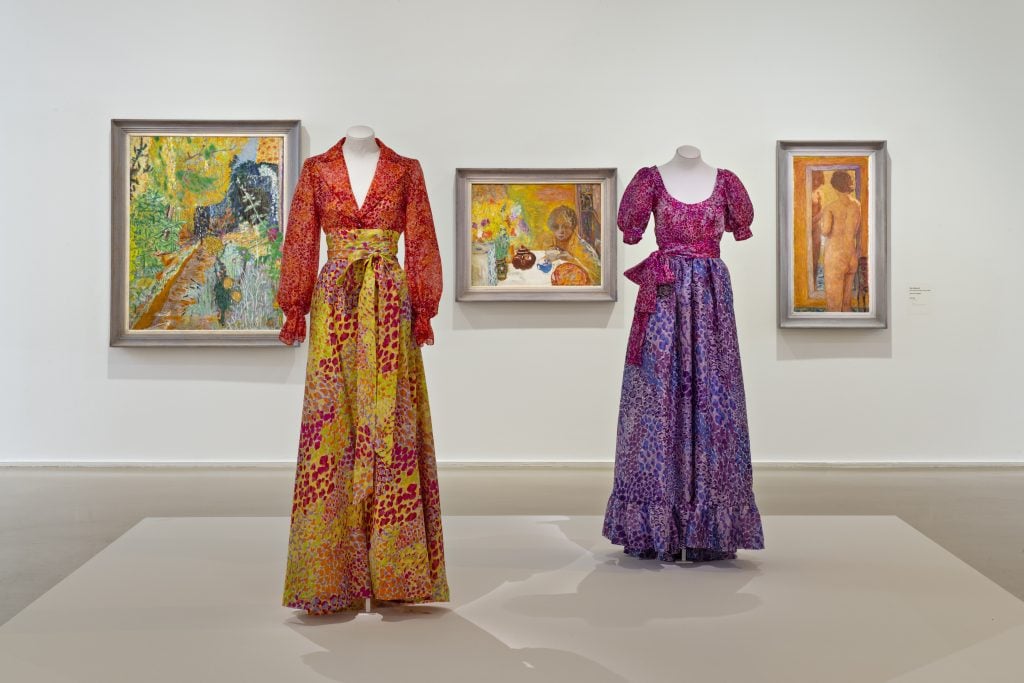
Ensembles from Yves Saint Laurent’s spring-summer 2001 collection, next to the Pierre Bonnard paintings that inspired them. © Nicolas Mathéus.
“What is so great about this project is that it is not one gigantic event taking over spaces usually devoted to temporary exhibitions, but the subtle introduction of a few Yves Saint Laurent pieces into what’s already at the heart of all of our institutions—our permanent collections,” said Charlotte Barat, the Musée d’Art Moderne de Paris’s associate curator.
The museum has integrated Saint Laurent pieces spanning the designer’s career, from his 1960s smoking jackets to his 2001 ensembles inspired by Bonnard. “It is really incredible to think that the same designer created all this—that the same designer is behind both the very graphic black-and-white dresses inspired by Matisse, and the luminous satin pieces full of vivid colors that we present in the Dufy room,” Barat said.
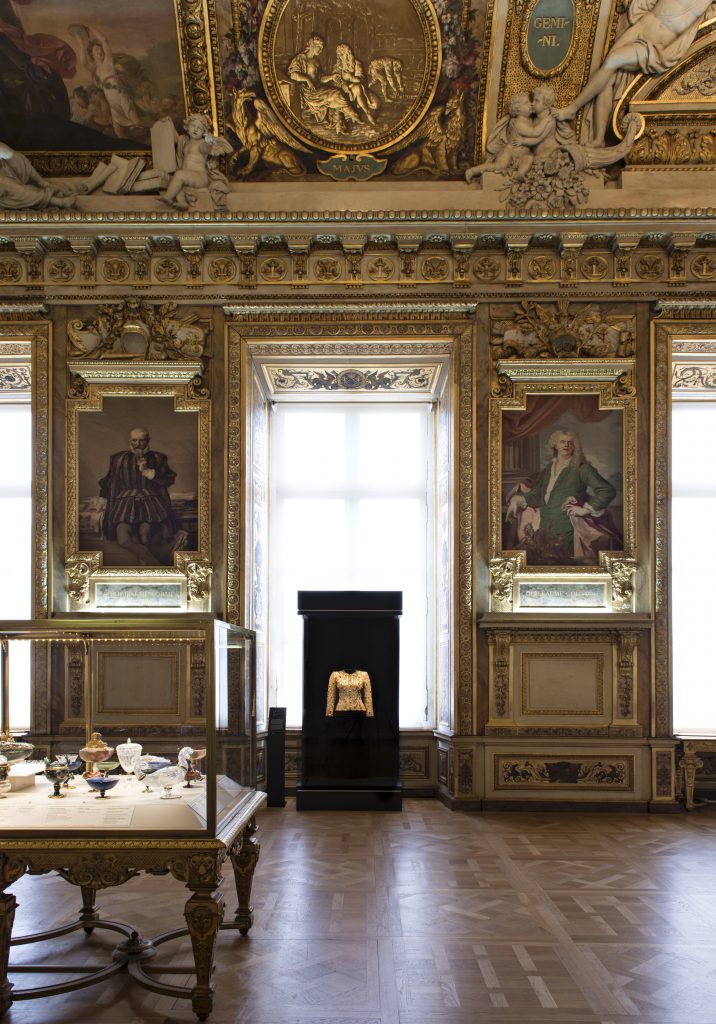
One of Saint Laurent’s embroidered jackets in the Louvre’s Galerie d’Apollon. © Nicolas Mathéus.
Designed by Charles Le Brun at the request of King Louis XIV, the museum’s gilded Galerie d’Apollon was the model for the Hall of Mirrors at the Château de Versailles and is now the setting for Saint Laurent’s heavily embroidered jackets cum objets d’art (along with the French crown jewels). Among them, he created Homage to Ma Maison, which is swathed in rock crystals, as a tribute to the many artisans who worked with him over the years; it also reflects France’s rich craft heritage.
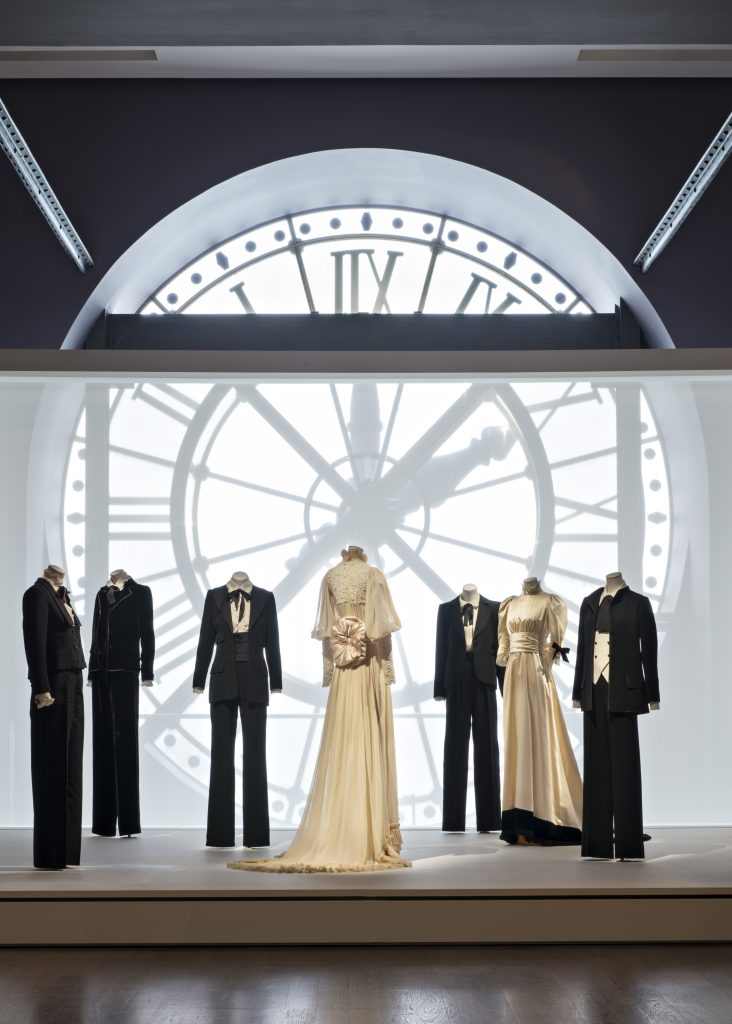
Saint Laurent “Smoking” tuxedos and satin dresses, the latter specially designed for the 1971 Proust Ball referenced in the Musée d’Orsay’s display. © Nicolas Mathéus.
“What’s interesting about Saint Laurent is that he had a multitude of inspirations,” said Cox. “We’re not just talking about a dialogue with a sculptor or a painter. There are so many other worlds that he also explored in his work—Asia, Russia, the [relationship] between masculine and feminine.” The latter was central to the structured “smoking tuxedos” that he famously designed for women.
Saint Laurent was also transfixed by the literature of Marcel Proust. “Like Proust I am fascinated most of all by my own perceptions of a world in transition,” he said. The Musée d’Orsay is displaying the satin dresses that he designed for guests of the Bal Proust, a 1971 ball hosted by the Baron and Baroness Guy de Rothschild at the Château de Ferrières.
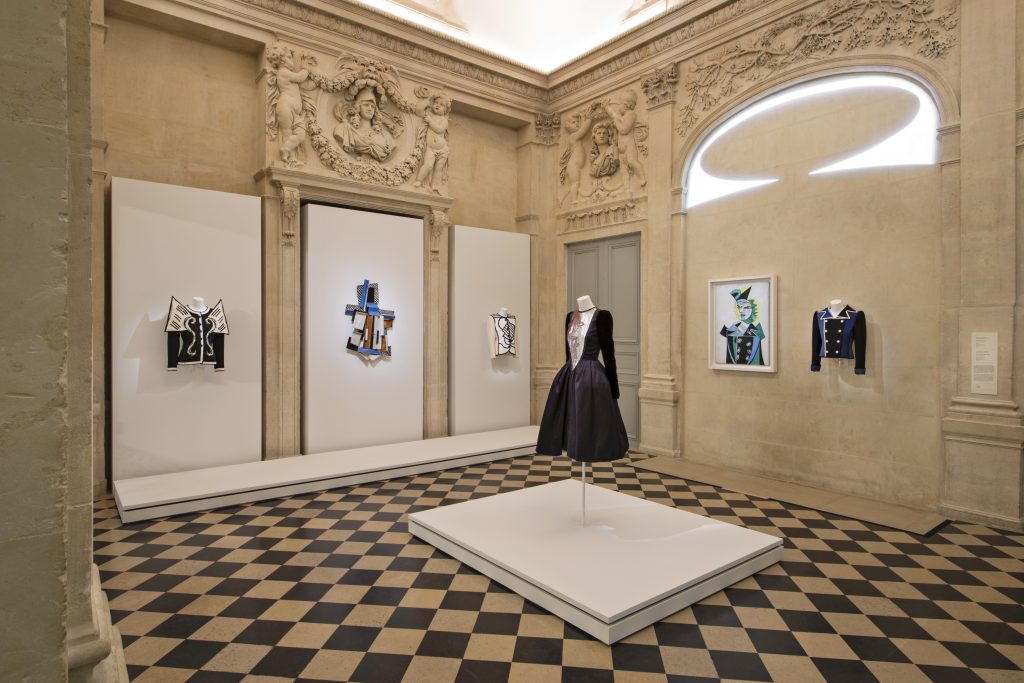
Yves Saint Laurent created more than one couture collection inspired by the works of Picasso. © Nicolas Mathéus.
“Picasso is genius in its pure state,” Saint Laurent once said. “It explodes with life and with honesty. Picasso is not purity. Is he baroque? He has several paths, several arcs, several strings to his bow.” In 1979, after attending the Ballets Russes, inspired by the costume maquettes that Picasso made for Sergei Diaghilev’s Three-Cornered Hat, he designed a collection in tribute to them both. And later, in 1988, Saint Laurent looked to the artist’s cubist works.
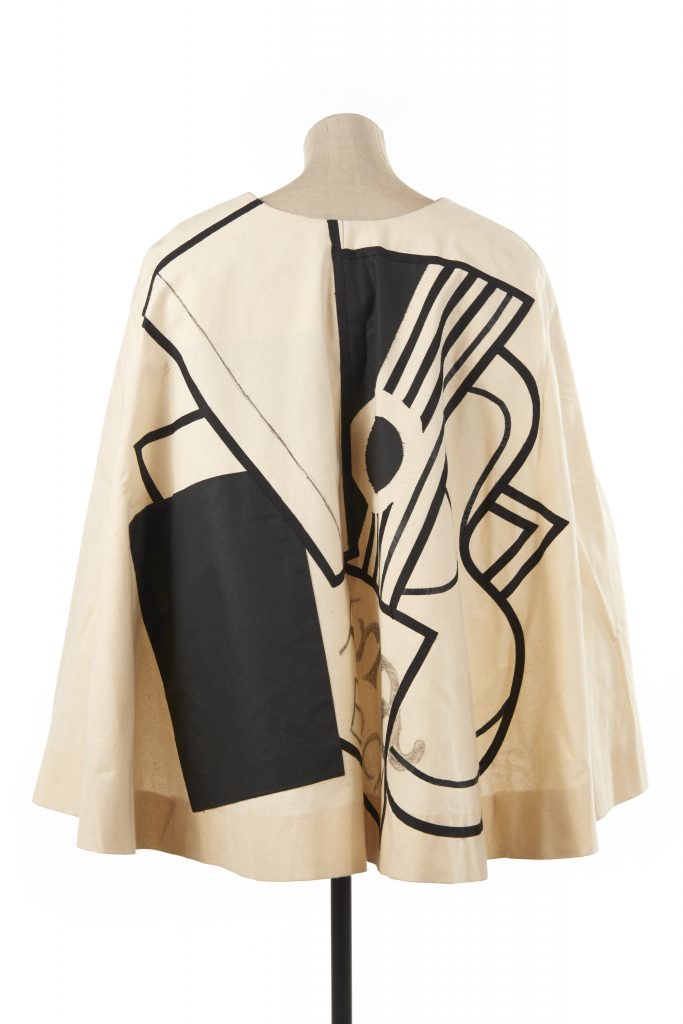
The toile of a cape that Yves Saint Laurent designed in homage to Georges Braque for spring-summer 1988. © Yves Saint Laurent @ Nicolas Mathéus.
Cox accompanied Saint Laurent to the Ballets Russes production that inspired the designer’s 1979 collection in homage to Picasso and Diaghilev. “The amount of drawings that he produced [afterwards was] phenomenal,” he said. The Musée Yves Saint Laurent Paris is not showing any clothing or accessories—instead, its displays focus on the designer’s creative process, from sketches to patterns to toiles (muslin prototypes) to final products.